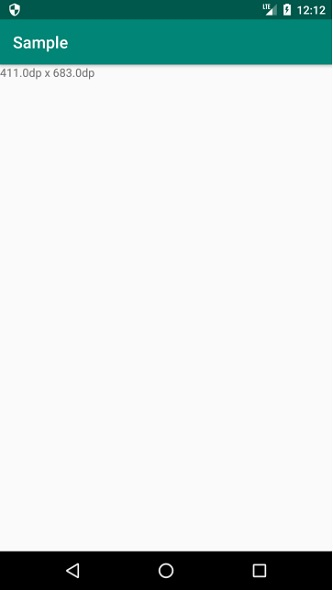1 Creating resources for varying screens
- Author: learn.microsoft.com
- Published Date: 04/04/2022
- Review: 4.93 (677 vote)
- Summary: · Android itself runs on many different devices, … This element is used to specify what screen sizes are supported by the application
- Matching search results: Android itself runs on many different devices, each having a wide variety of resolutions, screen sizes, and screen densities. Android will perform scaling and resizing to make your application work on these devices, but this may result in a …
- Source: 🔗
2 Supporting Multiple Screens | Android Developers
- Author: tool.oschina.net
- Published Date: 05/16/2022
- Review: 4.73 (397 vote)
- Summary: Declaring Tablet Layouts for Android 3.2 new! Using new size qualifiers; Configuration examples; Declaring screen size support
- Matching search results: Note: If you’re developing your application for Android 3.2 and higher, see the section about Declaring Tablet Layouts for Android 3.2 for information about new configuration qualifiers that you should use when declaring layout resources for …
- Source: 🔗
3 How Do I Set Android Layout To Support All Screen Sizes
- Author: androidconsejos.com
- Published Date: 12/28/2021
- Review: 4.59 (207 vote)
- Summary: · Support different screen sizes On this page. Create a flexible layout. Use ConstraintLayout. Avoid hard-coded layout sizes
- Matching search results: How To Use: Include implementation com.intuit.sdp:sdp-android:1.0.5 in your build.gradle , Replace any dp value such as 50dp with a @dimen/50_sdp like so: <TextView android_layout_width=@dimen/_50sdp android_layout_height=@dimen/_50sdp …
- Source: 🔗
4 Supporting Different Screen Sizes | Android Developers – MIT
- Author: stuff.mit.edu
- Published Date: 08/27/2022
- Review: 4.39 (245 vote)
- Summary: To ensure that your layout is flexible and adapts to different screen sizes, you should use “wrap_content” and “match_parent” for the
- Matching search results: The smallest-width qualifier is available only on Android 3.2 and above. Therefore, you should also still use the abstract size bins (small, normal, large and xlarge) to be compatible with earlier versions. For example, if you want to design your UI …
- Source: 🔗
5 How to support different screen size in Android?

- Author: tutorialspoint.com
- Published Date: 02/05/2022
- Review: 4.03 (298 vote)
- Summary: · This example demonstrates how to support different screen sizes in Android. Step 1 − Create a new project in Android Studio, go to File
- Matching search results: Let’s try to run your application. I assume you have connected your actual Android Mobile device with your computer. To run the app from the android studio, open one of your project’s activity files and click Run icon from the toolbar. Select your …
- Source: 🔗
6 Create a Flexible and Adaptive User Interface in Android with Java

- Author: openclassrooms.com
- Published Date: 01/23/2022
- Review: 3.8 (321 vote)
- Summary: · But I only have one folder for drawable/, layout/ and values/! How can Android tell which resources to retrieve? Very easily, with a naming
- Matching search results: This success has created a rather annoying problem for Android developers: Fragmentation. In 2017, there were about 24,000 different models of Android devices (each with their own screen sizes and resolutions, unique features, etc.) and each one …
- Source: 🔗
7 Handle Multiple Screen Sizes in Android
- Author: tothenew.com
- Published Date: 07/25/2022
- Review: 3.71 (221 vote)
- Summary: · To set up support for multiple device sizes in Android, add the element into the AndroidManifest.xml file
- Matching search results: As we design our UI for different screen sizes, we’ll discover that each design requires a minimum amount of space. So, each generalized screen size above has an associated minimum resolution that’s defined by the system. These minimum sizes are in …
- Source: 🔗
8 Support different screen sizes – Android Developers

- Author: developer.android.com
- Published Date: 06/22/2022
- Review: 3.42 (460 vote)
- Summary: · To ensure that your layout is responsive to different screen sizes, use wrap_content , match_parent , or 0dp (match constraint) for the width
- Matching search results: If you decide that you don’t want your app to run at certain screen sizes, you can set limits for how much your app should resize, or you can even restrict which devices can install your app based on screen configuration. For more information, see …
- Source: 🔗
9 Supporting Multiple Screens | Android Developers
- Author: dre.vanderbilt.edu
- Published Date: 08/03/2022
- Review: 3.37 (388 vote)
- Summary: In most cases, you can take advantage of density independence in your application simply by making sure that your layouts specify all dimension values in
- Matching search results: Even with the size- and density-compatibility features that the platform provides, you may still want to make adjustments to the UI of your application when it displayed on certain screen sizes or densities. You can do this by providing size- or …
- Source: 🔗
